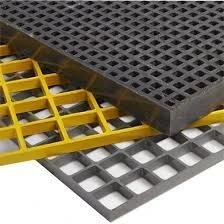loading...
- No. 9, Xingyuan South Street, Dongwaihuan Road, Zaoqiang County, Hengshui, Hebei, China
- admin@zjcomposites.com
- +86 15097380338
- Welcome to visit our website!
Properties and Applications of Glass Fiber Reinforced Polymer Rebar in Construction
Understanding Glass Fiber Reinforced Polymer (GFRP) Rebar A Modern Solution for Reinforcement
In the construction industry, innovation is critical for addressing the evolving demands of infrastructure and material performance. One such advancement is the introduction of Glass Fiber Reinforced Polymer (GFRP) rebar, which has gained attention as a sustainable and durable alternative to traditional steel reinforcement bars. This article explores the properties, advantages, and applications of GFRP rebar, highlighting its growing importance in modern engineering.
What is GFRP Rebar?
GFRP rebar is a composite material made from glass fibers embedded in a polymer matrix. The glass fibers provide tensile strength, while the polymer offers resistance to corrosion and chemical attack. This composite is produced through processes such as pultrusion, which results in a lightweight yet strong reinforcement bar. GFRP rebar is available in various diameters and lengths, catering to different structural requirements.
Key Properties of GFRP Rebar
1. Corrosion Resistance One of the most significant advantages of GFRP rebar is its excellent resistance to corrosion. Unlike steel, which can rust when exposed to moisture and salt, GFRP remains unaffected by harsh environmental conditions. This property makes it an ideal choice for structures in coastal areas, bridge decks, and parking garages where exposure to de-icing salts is common.
2. Lightweight GFRP rebar is significantly lighter than steel, with a density only about one-fourth that of traditional reinforcement bars. This characteristic not only facilitates easier handling and transportation during construction but also allows for reduced labor costs and faster installation times.
3. High Strength-to-Weight Ratio Despite its lightness, GFRP rebar offers a high strength-to-weight ratio. The tensile strength of GFRP can surpass that of steel, making it a suitable option for high-performance concrete structures that require robust reinforcement.
4. Non-Magnetic and Non-Electrical Conductivity GFRP is an electrically insulating material, which is crucial in applications near sensitive electronic equipment or in environments where magnetic fields could pose issues. This feature enhances safety and expands the applicability of GFRP in various industries.
5. Durability The durability of GFRP rebar is noteworthy, as it can withstand extreme temperatures and is resistant to many chemicals. This longevity reduces maintenance requirements and enhances the lifespan of the structures where it is used.
Advantages of GFRP Rebar
The benefits of using GFRP rebar over traditional steel rebar are multifaceted
glass fiber reinforced polymer gfrp rebar

- Economic Lifecycle Cost While the initial cost of GFRP rebar may be higher than that of steel, its long-term advantages, such as reduced maintenance and increased lifespan, can lead to lower overall lifecycle costs. This aspect is particularly relevant in infrastructure projects where durability is paramount.
- Sustainability GFRP rebar contributes to sustainable construction practices. Its manufacturing process often utilizes recycled materials, and its long-term durability reduces the need for frequent repairs or replacements, ultimately lowering the carbon footprint associated with infrastructure maintenance.
- Design Flexibility The unique properties of GFRP allow for innovative design approaches. Engineers can utilize GFRP rebar to create lighter structures with complex geometries, optimizing material usage without compromising structural integrity.
Applications of GFRP Rebar
GFRP rebar is becoming increasingly prevalent in various applications, including
- Civil Infrastructure Bridges, tunnels, and retaining walls are ideal candidates for GFRP reinforcement due to their exposure to harsh environmental factors.
- Coastal and Marine Structures The corrosion-resistant nature of GFRP makes it suitable for docks, piers, and other waterfront constructions.
- Industrial Facilities Chemical processing plants and waste treatment facilities can benefit from GFRP rebar's resistance to aggressive chemicals.
- Rehabilitation Projects GFRP rebar is often used in retrofitting existing structures, enhancing their strength and durability while minimizing added weight.
Conclusion
In conclusion, Glass Fiber Reinforced Polymer (GFRP) rebar represents a significant advancement in construction materials. Its unique properties—such as corrosion resistance, lightweight features, and durability—make it a compelling choice for various applications in modern engineering. As the industry continues to seek sustainable and long-lasting solutions, GFRP rebar is poised to play a crucial role in shaping the future of infrastructure development. As awareness and acceptance of this innovative material grow, it is likely that GFRP rebar will become a standard component in construction practices worldwide.
-
Transform Your Spaces with FRP Grating SolutionsNewsNov.04,2024
-
The Versatility and Strength of FRP RodsNewsNov.04,2024
-
The Excellence of Fiberglass Water TanksNewsNov.04,2024
-
The Benefits of FRP Grating for Your ProjectsNewsNov.04,2024
-
Elevate Your Efficiency with FRP Pressure VesselsNewsNov.04,2024
-
Welcome to the World of FRP Pressure VesselsNewsOct.12,2024
-
Unveiling the Future of Filtration: Why FRP Filter Vessels are a Game ChangerNewsOct.12,2024
